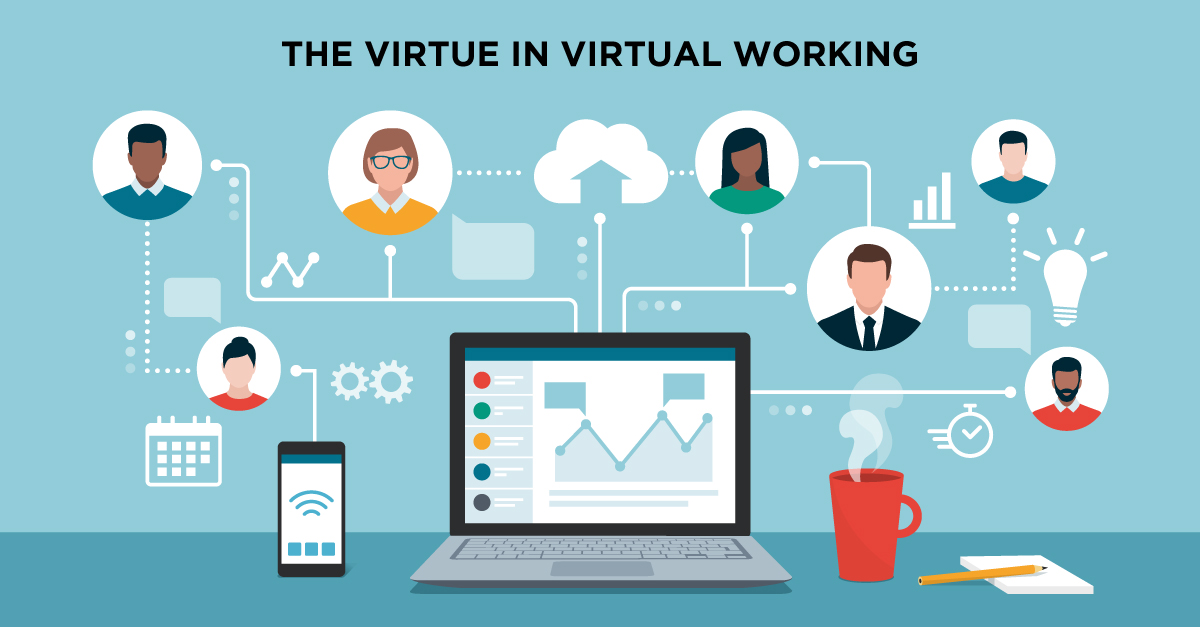The virtue in virtual working
Daily users of Zoom, a video conferencing app, increased to 200 million in March from a previous high of 10 million, according to the company CEO(1). Zoom’s overnight traction is among the many knock-on effects of the COVID-19 outbreak. This pandemic has disrupted lives and livelihood, but maintaining a semblance of business continuity is essential for organizations, bearing in mind the long haul. The ongoing circumstances have prompted businesses to consider maximizing teleworking and introducing work-from-home flexibility.
Even organizations with an entrenched operational aversion to remote working are now jumping on the work-from-home bandwagon with relative ease, much to their own surprise. Stepping back from the current context, industry trends were already moving in favour of virtual working, before the COVID-19 pandemic added to the impetus. Initially however, the teleworking revolution was spearheaded by Millennials, who, thanks to their staggering numbers often sway industry trends. According to a study, 85% Millennials prefer working from home, while 40% of them would not mind giving up some salary if they could work remotely(2). These numbers beg the question: what is the virtue in virtual working?
Where work from home wins
According to a comprehensive study conducted in the U.S. by Global Workplace Analytics, organizations can save up to $11,000 per person per year, by allowing employees to work from home. AT&T saves at least $30 million via remote work(3). This finding is consequential under the current circumstances, as organizations contemplate cutting corners, in view of the seeming inevitability of at least a short term global recession. However, organizations prone to micromanaging have sometimes cited lack of productivity in remote workers, as a reservation. A recent study by Harvard University provides a counter argument to such presumptions. According to the results of this research, people who are given the freedom to “work from anywhere” were 4.4% more productive than those who have more rigid workplace requirements(4).
Many other reliable studies give an edge to virtual working as well, with advantages ranging from significant drop in stress levels to a better diet among employees. The flexibility offered by remote working seems to help professionals strike the right work-life balance. Experts have also established a definite correlation between employee engagement and flexible working – especially within the context of creative work, where a quiet environment and lack of distractions can add to the quality of output.
From a broader standpoint, fewer face-to-face interactions and in-person meetings can reduce unnecessary travel. In busy metropolitan areas, where travel entails jostling through rush-hour traffic and long commuting hours, the stress can take its toll on both mental and emotional health, leading to an adverse impact on productivity. Organizations can also rake in profits made from reduced infrastructure expenses relating to usage of water, electricity and physical space. It should come as no surprise that technology giants like Dell were hoping to allow at least half of their workforce to operate remotely, well before Covid-19 struck.
Virtual working in real estate
Real estate, by virtue of its inherent characteristics, revolves around physical structures. It is therefore unsurprising that COVID-19 induced lockdowns have disrupted real estate businesses to an unprecedented level. Virtual Reality (VR) and Augmented Reality (AR), which have been gaining steady ground in real estate, are experiencing increased adoption in brokerage. The COVID-19 lockdown has led to a rise in virtual tours, with interested parties navigated properties through 3D images. Zoopla, a popular marketplace, witnessed 215% increase in visitors who availed of virtual property tours(5).
Real estate agents are now using facetime and WhatsApp video calling services, to connect with prospective buyers and give them a visual experience of properties, without the need for them to leave their homes. However, experts opine that these measures may not result in conversion. As property purchases tend to be capital-intensive, it’s unlikely that on-site visits and inspection will ever be redundant. Nevertheless, virtual visits, irrespective of the pandemic, do offer some inherent advantages over on-site visits. For starters, agents can offer virtual visits to a larger customer base, without having to go through multiple rounds of laborious in-person pitching. From the buyer’s perspective, they can avail unlimited virtual visits, regardless of distance and time. In many cases, this has resulted in shorter vacancy periods, as agents optimize their productivity and more prospective customers than ever before are able to consider any given property as an option.
All disruption is an opportunity
Tech-driven realty firms operating in competitive markets are seeing new opportunities emerge due to the pandemic, where others see obstacles. VR and AR-enabled software, which enables 3D capturing of a property and a 360-degree view, are proving to be key differentiators in prime markets like New York, where governing bodies have classified real estate business as “essential”, albeit with some caveats. Indefinite lockdown and dire economic outlook could incentivize more agents to follow suit, especially in markets such as London and Dubai, where the assimilation of technology in real estate has already been exemplary.
Remote working, whether in real estate or any other industry, was a disruption that was waiting to happen, but the Covid-19 outbreak has certainly added to its more rapid adoption. Extraordinary circumstances change the risk versus reward equation in taking on change, and the ongoing pandemic has triggered a rapid reset of priorities as well. While the current circumstances are far from ideal, they could provide just the right context for virtual working to reach critical mass and begin to be far more commonplace, than in the past.
- https://venturebeat.com/2020/03/26/houseparty-discord-zoom-and-marco-polo-downloads-explode-amid-coronavirus-pandemic/
- https://www.flexjobs.com/blog/post/survey-changing-workplace-priorities-millennials/
- https://globalworkplaceanalytics.com/telecommuting-statistics
- https://hbswk.hbs.edu/item/how-companies-benefit-when-employees-work-remotely
- https://www.ft.com/content/d795c82c-74e7-11ea-90ce-5fb6c07a27f2




